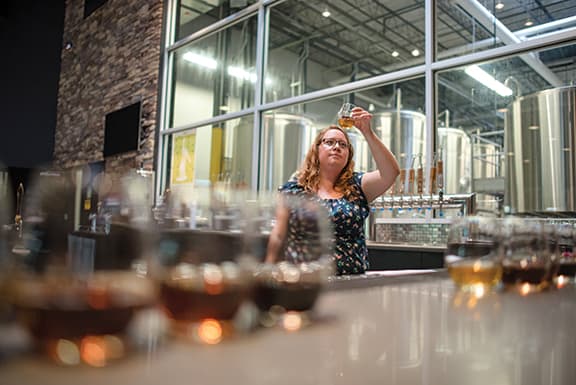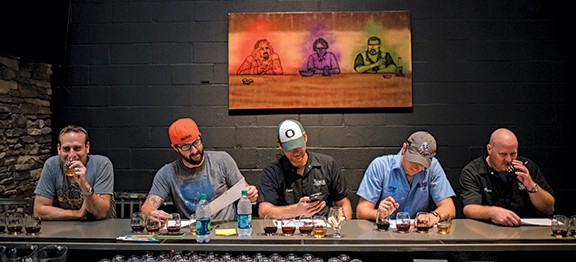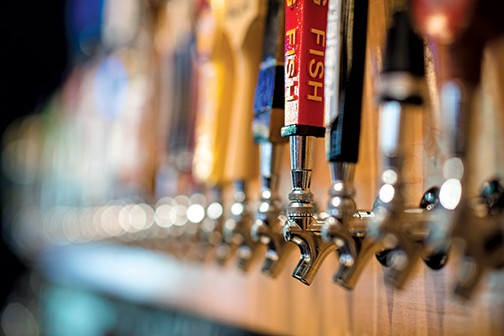Female beer makers, once called “brewsters” are gaining ground in the craft industry
STORY BY Rachel Rappaport PHOTOGRAPHY BY Mary C. Gardella
NOVEMBER/DECEMBER 2015
Tori Marriner has observed a subtle change in drinking habits among women. At one time, beer and wine at Victoria Gastro Pub, the Columbia  restaurant she owns with her family, might have been roughly split by gender, with the preponderance of suds sold to men. Lately, she says, “Women are drinking more beer than ever before.” The shift, she says, may be due to beer’s new artisanal quality. “There are so many more styles and flavors,” she points out. “It’s no longer just pick up a six pack of Bud.”
restaurant she owns with her family, might have been roughly split by gender, with the preponderance of suds sold to men. Lately, she says, “Women are drinking more beer than ever before.” The shift, she says, may be due to beer’s new artisanal quality. “There are so many more styles and flavors,” she points out. “It’s no longer just pick up a six pack of Bud.”
The Marriner family recently launched Manor Hill Brewing Company in Ellicott City, selling the beer to local restaurants, including Victoria Gastro Pub. Manor Hill is just one of a burgeoning industry of craft breweries. The Brewers Association, the largest professional association for craft brewers in the U.S., reports that breweries are opening at a rate of 1.5 per day nationwide. Maryland has 52 breweries, says Kevin Atticks, executive director of the Brewers Association of Maryland, and founder and CEO of Grow and Fortify, a Baltimore-based organization that represents and supports the state’s wine, beer and spirits producers. According to Brewers Association surveys, Maryland beer makers produced 210,778 barrels in 2014, with a $455 million economic impact.
The numbers prompted the Howard County’s Tourism and Visitors Bureau to launch a “beer trail” app earlier this year. The app leads users to breweries in the region.
Atticks isn’t surprised by women’s embrace of craft beers. While the consumers of wine are “overwhelmingly women,” Atticks says, “The complex flavor profiles of craft beers begin to resemble the way we talk about wine.” Moreover, like wine, “Craft beer is something you can learn about locally, visit the breweries, meet the producers.” As a demographic, he points out, “Women are interested in the experience, the background and the story.”
Marriner reports that close to half of the restaurant’s Beer Club members are female, and beer dinners featuring guest breweries are wildly popular. According to the Brewers Association, women consume about 30 percent of all craft beer sold. At the same time, women are also brewing in greater numbers than ever before. While still small, these numbers are growing.
For most of their history, beer was a domestic beverage, brewed at home by women when beer and ale were more widely consumed than water, according the National Women’s History Museum. Female brewers were called “brewsters.” But as beer became more commercial in the 18th century, it began to be manufactured by breweries operated by men. The new craft beer world has welcomed more women back into the fold.
At North Laurel’s Jailbreak Brewing Company, Maggie Wear heads up the quality control lab. One of three women with essential jobs at the brewery, Wear conducts taste tests with members of the staff. They taste several samples of the same beer, all brewed at different times, to evaluate the flavor consistency.
 Wear, who has a degree in yeast genetics and is currently completing her doctorate in yeast biochemistry at Uniformed Services University in Bethesda, analyzes such data as microbial growth and alcohol, bitterness and color. Wear considers her job one of analytics and biochemistry, advising the brewers on how to tweak each batch to ensure consistency. Welcome to Scoville, for example, has jalapeno peppers.
Wear, who has a degree in yeast genetics and is currently completing her doctorate in yeast biochemistry at Uniformed Services University in Bethesda, analyzes such data as microbial growth and alcohol, bitterness and color. Wear considers her job one of analytics and biochemistry, advising the brewers on how to tweak each batch to ensure consistency. Welcome to Scoville, for example, has jalapeno peppers.
“The Scoville scale is the measure of heat in peppers, so it’s kind of a play on words,” Wear explains. “Welcome to Scoville meaning not very spicy – we like puns a lot.” Another Jailbreak concoction is Feed the Monkey, an orange wheat beer with a lot of banana flavor – though there are no bananas in the beer. “The flavor comes from the yeast,” says Wear. “The yeast fermentation produces a banana-flavored ester” – or fruity flavor – similar to the taste produced by ripened bananas.
The Jailbreak taproom has a large granite bar and tables made with reclaimed wood and pipes, where visitors can sample beer and where the company hosts special events. The brewery is spotless and efficiently organized, from a tiny room housing the beers Wear is experimenting with to the refrigerator filled with beer samples, hops and fresh jalapenos and cucumbers used for the Scoville and Q.Cumber beers.
Wear says the convivial atmosphere at Jailbreak drew her to leave a career in academic research. “The thing that drew me to science in the first place is you’ll never have the same day twice,” she says. At a brewery, “It’s the same thing, only without the hierarchy.” While brewers don’t always talk about their craft in terms of science, she says, “The science is real and present.”
Jennifer Degele, Ellicott City native and senior sales manager at Jailbreak, was also drawn to the camaraderie at the company. “It’s like home here,” she says. “Anyone who comes through the taproom doors or sees us out and about can see that.”
Jailbreak was started by Erica and Kasey Turner and their friend Justin Bonner. Kasey was a home brewer when, in the spring of 2013, the threesome decided to open a brewery. By that summer Erica had quit her job as a network intelligence analyst and, along with newly hired brewer Ryan Harvey, the team was making 50-plus batches on a small half-barrel pilot brewing system, testing recipes for what would become Jailbreak (These days, Jailbreak uses systems that can handle up to 40 barrels.). At this point, Erica was working as Harvey’s apprentice, learning the ropes as a fledgling brewer. Meantime, the company built a warehouse, now the home of Jailbreak.
The two biggest challenges of brewing, says Turner, are lifting heavy bags of hops and full kegs, as well as finding the specialty clothing brewers wear – such as flame-retardant shirts – in her size. Currently on maternity leave, Turner has taken on tasks she can do at home, tracking inventory, writing customer invoices and conducting financial analyses, as well as tracking the operations at the brewery.
Randi Benesch, a self-described “beer lover by marriage” says her husband Adam Benesch’s love of beer was infectious. A home brewer turned brewery owner, Adam, along with Kevin Blodger, a college friend and serious brewer, and Jon Zerivitz – another friend with a background in design and marketing – took the leap into professional brewing. In 2012, they launched Union Craft Brewing in Baltimore with Duckpin Ale – which remains a favorite.
Benesch says she was ready for Adam to “graduate” the home kitchen after he ruined their cooktop when a cauldron of beer boiled over. While she has a full-time job as director of the Gordon Center for Performing Arts in Owings Mills, Benesch continues to pitch in at Union’s large events. Beer, she says, has had an outsized impact on their lives. Family trips with their two children (aged 7 and 10) often involve a detour to visit other breweries. “It’s been a crazy fun ride,” she says. Benesch and the other brewers’ spouses, she says, had a little trouble adjusting to all the events required by the business. “And ‘work’ really means hanging out at bars and events socializing, drinking beers and having a good time,” she adds. By now, she says, “We’ve all gotten used to the new normal.”
Watching the business grow from an idea to what it is now, she says, “has been incredible. And I can’t wait to see what the future holds.”
The future certainly looks promising for women in the craft beer industry in Howard County and in Maryland as a whole, as they carve out their niche.
Janet Gates started making wine at home in 2000 but gave up after a few bad batches. Then in 2007, she decided to take up brewing beer at home. She did some research, joined homebrewtalk.com, a home brew forum, and took a trip to Maryland Homebrew in Columbia to purchase equipment. When her first batch turned out “pretty good,” she says, she kept going.
“My biggest fear was making bad beer and wasting time and money,” says Gates. She spent a lot of time reading about brewing and concluded that, “It’s perfectly safe.” She keeps a cup of ice cubes in a pot by the stove to keep the temperature regulated while the wort – or mix of grains and water – is boiling, and carefully checks sugar levels before bottling to ensure that the fermentation process won’t produce too much CO2 – which can lead to bottles exploding.
“In all my years, I’ve never had a bottle explode,” she says. She knows home brewers who wrap bottles in cardboard boxes tied up inside extra strength yard bags just in case. Even so, she says “If something like that is going to happen, you usually know about it long before it does.” She usually opens a bottle every now and then to check the CO2 – or fizz.*
HOW TO HOME BREW
1 Heat water and mash grains or stir in extract, depending on your preference (or level of commitment).
2 Boil the wort (the liquid, grains and sugar).
3 Cool, add yeast and ferment the beer (about 2-3 weeks).
4 Check sugar levels to see if fermentation is complete.
5 Bottle or keg. Most home brewers use recycled bottles and clamp on new caps with a special capping tool.
6 Let bottles sit at 70 degrees for about three weeks to carbonate.




